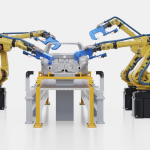Facing rising labor intensity from e-commerce fulfillment, Gap Inc. is using mobile trailer-unloading robots to restructure inbound workflows across its North American distribution network. The move is not just about automation, it’s about safer jobs, smarter scheduling, and meeting the labor demands of e-commerce growth.
Redesigning Inbound With Mobile Autonomy
Gap Inc.’s deployment of Boston Dynamics’ Stretch robots marks more than a tactical automation upgrade, it’s a strategic reallocation of labor where it’s most constrained. Rather than scaling headcount to keep pace with growing online fulfillment demand, Gap is rerouting inbound effort with robots that unload trailers autonomously. The units operate inside trailers across facilities in Tennessee, California, New York, and Ohio, lifting up to 50-pound cartons, adjusting to box variance, and orienting labels for downstream scanning, tasks that previously required up to 15 people per shift.
Critically, these robots aren’t bolted to fixed infrastructure. Stretch units run untethered, require no compressed air or conveyor integration, and can be repositioned across trailers and dock doors. That flexibility reduces deployment friction and enables site-level agility during seasonal volume shifts or facility disruptions.
But their role isn’t purely mechanical. Gap is using Stretch to rebalance labor scheduling, moving from weekend-heavy shifts toward more stable weekday patterns. The technology has also become a workforce retention tool: long-time inbound employees now avoid repetitive strain injuries while shifting toward roles with greater decision-making and oversight responsibility.
From Robotics-as-Tool to Robotics-as-Policy
What’s emerging is a broader shift in how inbound is governed. Instead of layering automation on top of existing workflows, Gap is redefining which tasks are human-led versus machine-led. The decision to invest in inbound robotics, rather than in further downstream automation, reflects a key friction point in retail distribution: online orders, with their smaller batch sizes and higher service expectations, are upstreaming fulfillment strain.
Stretch’s integration with Gap’s automated storage and retrieval systems (ASRS) adds another layer: AI-based label recognition aligns the robot’s actions with the broader orchestration system, improving throughput not just at the trailer dock but across the entire facility. The move builds on earlier investments, including Kindred robotic sorters and Exotec Skypods, as well as Gap’s 2021 acquisition of AI software firm CB4.
While these systems are effective, their value depends on operational governance. Boston Dynamics engineers can train warehouse staff to operate Stretch within days, but sustaining performance still requires tight coordination between robotics, scheduling, and facility design. That’s where Gap has focused: not on automation for its own sake, but on aligning it with measurable operational relief.
Rethinking the ROI Equation in Warehouse Automation
The value of automation is increasingly being measured in terms beyond throughput or headcount reduction. As wage volatility rises across Mexico, Eastern Europe, and Southeast Asia, and as labor markets tighten in North America, automation is becoming a hedge against operating risk, not just a lever for efficiency.
Gap’s deployment of mobile inbound robotics illustrates a growing trend: investing in systems that preserve labor optionality, reduce exposure to scheduling volatility, and create time buffers for downstream execution. For logistics networks strained by unpredictability, the next competitive edge may come not from scale, but from how flexibly capacity can be repurposed in real time.





